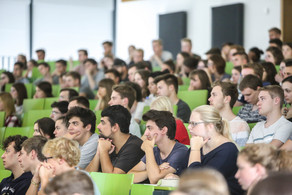"Best Paper Award" for Contribution on UWB-Based Indoor-Navigation for Robotic Applications
- News
- CPS.HUB
Janis Tiemann won the highly-desirable "Best-Paper-Award“ at this year’s International Conference on Indoor Positioning and Indoor Navigation (IPIN) in Sapporo, Japan. In his paper, titled "Scalable and Precise Multi-UAV Indoor Navigation using TDOA-based UWB Localization“, Tiemann suggests a new method for highly precise and scalable radio-based positioning. This method fulfills an important requirement for the deployment of autonomous robots in areas such as logistics and emergency services. The judges honored the innovative system concept as well as the extensive validation through experiments. The papers are important contributions to the subproject A4 of the DFG SFB 876 "Ressourcen-effiziente und verteilte Plattformen zur integrativen Datenanalyse" and also to CPS.HUB/NRW.
Facts and link to the awarded article:
J. Tiemann, C. Wietfeld, "Scalable and Precise Multi-UAV Indoor Navigation using TDOA-based UWB Localization", In 2017 International Conference on Indoor Positioning and Indoor Navigation (IPIN), Sapporo, Japan, September 2017.
Abstract - Ultra-wideband wireless positioning technologies based on IEEE 802.15.4a have gained attention for various use cases requiring highly precise localization. Multi-rotor unmanned aerial vehicle (UAV) systems provide several sensors for stabilization and navigation. However, absolute indoor positioning poses a problem for autonomous robotic systems. The specific challenge addressed in this paper is enabling novel applications with autonomous UAV systems through tight integration with scalable and precise receiver-side time-difference of arrival (TDOA) based ultra-wideband (UWB) indoor localization. For the in-depth validation of the proposed approach, several experiments are performed. One proves the repeatability of the proposed method by following a predefined trajectory ten times achieving close to optical motion-capture based control performance, with a 3rd quartile of the alignment error lower than 10 cm. Another experiment addresses the simultaneous flight of three UAVs in close proximity and delivers an analysis of the real-time capabilities which in turn proves the multi-user scalability. The last experiment demonstrates a user-interactive application of the proposed approach in a logistics environment. A video along with the raw samples, reference data and processed positions of the aforementioned experiments is provided alongside this work.





